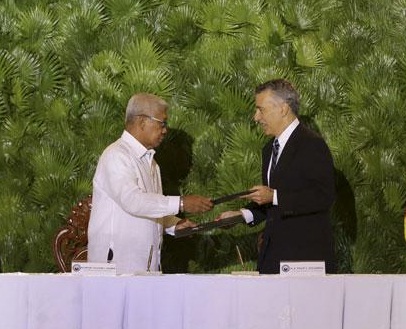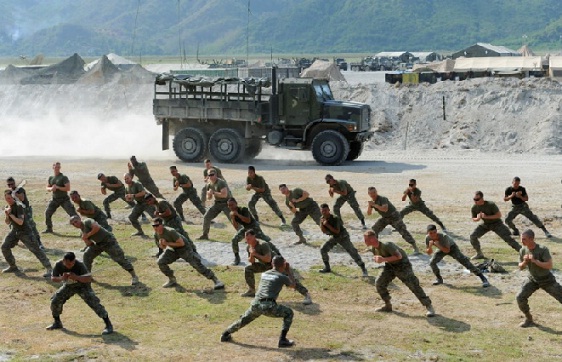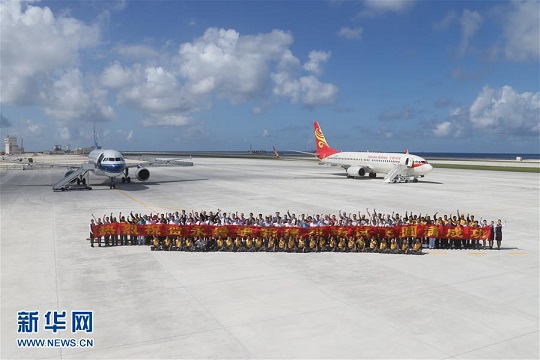
The military’s spokesman even said from where the American troops would be based in the Philippines, it would take a shorter distance to the South China Sea where China has done massive reclamations around the reefs and rocks they occupy.
As if the American troops based in the Philippines would simply and quickly rush to the Spratlys and battle with Chinese Navy if China clash with the Philippine Navy in the disputed waters.
It would be good to refer to the Senate hearing in on EDCA in December 2014 when Defense Secretary Voltaire Gazmin was compelled to tell the public what EDCA is really about upon incisive questioning by Sen. Miriam Santiago, chairperson of the Senate Committee on Foreign Relations.
In that hearing, Santiago asked Gazmin: “What will the US do if a Chinese ship fires at a Philippine ship in the West Philippine Sea?”
Gazmin answered, “It’s part of the agreement that we can pull the US to join us in the fight.”
If he thought he can get away with that answer which was not exactly truthful, Santiago asked if the U.S. would immediately deploy planes and ships to fire at the Chinese, Gazmin had to admit that the deployment would go “through a process.”
Pressed further how long would the process take, Gazmin had to admit again that “The process takes long.”
Santiago made a realistic conclusion: “By that time, the [Philippine] ship has already sunk.”
The process Gazmin referred to is the provision in the 1951 Mutual Defense Treaty that an armed attack in the Pacific Area on either of the Parties would be dangerous to its own peace and safety and declares that it would act to meet the common dangers in accordance with its constitutional processes.”
In the U.S. “Constitutional processes” means the President would have to ask approval from the Congress which could take a lot of debate and time.

Philippine officials continue deluding the public that China would be deterred by the presence of American troops in the Philippines to carry out whatever plans it has to protect its interests when in fact the reality on the ground is the opposite.
If one looks at the timeline of China’s moves related to the South China Sea conflict, it can be said that EDCA hastened or at least was one of the reasons for China’s recent expansion in the South China Sea.
Tension in the South China Sea in the last three years remained even after the two-month standoff in Scarborough Shoal over the arrest of Chinese fishermen on April 8, 2012 ended. Two Chinese ships remained in the area giving the Chinese control over the disputed rock 124 nautical miles from the Zambales.
The Scarborough incident triggered the filing by the Philippines of a suit before the United Nations Arbitral Tribunal questioning China’s nine-dash line map in January 2013.
Negotiations for EDCA started in August 2013. The Aquino government agreed to an increased presence of American troops in the country made possible by the 1999 Visiting Forces Agreement after U.S military bases were closed in 1992. Before that, in view of the Constitutional ban on permanent presence of foreign troops in the country, the Philippine government from the time of Gloria Arroyo presidency allowed “rotational” presence of U.S. troops in the country. An agreement on PH-US Enhanced Defense Cooperation Agreement of EDCA was signed on April 26, 2014.
In Dec. 2013, China started reclaiming land in Spratlys. By June 2015, the U.S. Defense Department said China has reclaimed 2,900 acres of land mass transforming the eight rocks and reefs it occupies into islands. China has also constructed installations in the reclaimed islands.

Last week, China conducted test flights in Fiery Cross Reef, one of the man-made islands.
Buoyed by the High Court’s decision, Defense Ministry Spokesman Peter Paul Galvez now talks of joint patrol of Philippine and U.S. ships in the disputed waters.
“We are suggesting that we also patrol the area together. There is a need for more collaborative presence in the South China Sea,” Galvez said.
Lawyer Harry Roque, who was one of those who questioned the constitutionality of EDCA before the Supreme Court, asked, “What joint patrol” is Galvez talking. With only one or two ships, the Philippines has no capability to conduct joint patrol with the U.S., Roque said.
What would happen, Roque said, is the Philippines to just provide a front for the U.S. presence in the South China Sea. That would be “subterfuge,” he said.
Roque said joint patrols involving the U.S. under EDCA would only increase tension in the South China Sea.
You write: In the U.S. “Constitutional processes” means the President would have to ask approval from the Congress which could take a lot of debate and time.
The President of the US has to consult with Congress to declare war, but not to exercise discretion in defending US interests or fulfill obligations. Still, the Philippine ship would surely sink by the time Obama himself gave approval to shoot. But I hardly think that is the point. The point is how to stop China from being irresponsible and gobbling up Philippine territory and resources.
The article seems to defend Senator Santiago’s view that the US should not be allowed to rotate troops through Philippine bases. Are we all in agreement that Senator Santiago and Harry Roque should determine Philippine defense policy?
“If one looks at the timeline of China’s moves related to the South China Sea conflict, it can be said that EDCA hastened or at least was one of the reasons that China expanded in the South China Sea.”
China took mischief reef, an area within RP EEZ in 1994. Im sure EDCA wasnt the reason china is expanding. VFA wasnt conceived yet. Thats just the way communists work. They take whatever they can. President Ramos should have done something while the chinese just had a nipa hut in stilts in mischief reef. What is important is to protect what we have now and stop crying about what we lost especially reed bank.
…to protect what we have now especially reed bank…
Jake, read this:
China’s occupation of Mischief Reef was not a bolt from the blue; it was preceded by a chain of events that began with a falling-out with the Philippines over hydrocarbon exploration in the northeast region of the Spratlys.
Joint development talks between China and the Philippines over gas-rich Reed Bank broke down in early 1994; in May, Manila decided to grant a six-month oil exploration permit to Alcorn Petroleum and Minerals.27 The Philippines was interested in collecting seismic data on the seabed southwest of Reed Bank. Manila hoped the contract would remain a secret, but news of the collaboration soon leaked. Beijing swiftly issued a statement reasserting its sovereignty over the area covered by the license and ignored Manila’s belated invitation to become a partner in the project. Manila back-pedaled on the diplomatic front for weeks, but the damage had been done. By secretly licensing an exploration effort the Philippines had appeared to engage in unilateral efforts to exploit the natural resources of the Spratlys.
Stung by Manila’s “betrayal,” China decided to advance eastward for better surveillance coverage of any Philippine-sponsored oil exploration. Mischief Reef is in the lower-middle section of the Alcorn concession; a presence there would also strengthen China’s hand were petroleum ever to be discovered in the area. The Chinese post on Mischief Reef was discovered by Filipino fishermen in February 1995, the advanced state of its buildings indicating that construction had begun in the fall of 1994, just a few months after Manila’s “faux pas.” China had quietly advanced onto the reef because it believed physical occupation was the only method by which Chinese interests could be protected. Beijing’s own misstep was in not foreseeing that this characteristically “defensive” response would be interpreted as offensive.
Read the whole article: Calculating China’s Advances in the South China Sea
Identifying the Triggers of “Expansionism”
http://www.globalsecurity.org/military/library/report/1998/art5-sp8.htm
It’s written by
Lieutenant Michael Studeman, U.S. Navy
When I said “expanded”, it meant the recent reclamations which as the timeline showed started Dec. 2013.
I’ll edit to specify recent expansions.
I think those expansions are a prelude to the invasion of James Shoal and the nearby indo malaysian waters. China can now land jets to protect the Straight of Malacca. If they are to invade the Philippines, they will take Batanes, not Palawan. That will open up the Pacific for them.
Those island building spree was hastened to thwart UNCLOS ruling. EDCA wont do anything to the artificial islands. It is fait accompli. Im hoping that EDCA can prevent us from losing more territory in the SCS as 80% of the nations protein requirement come from there.